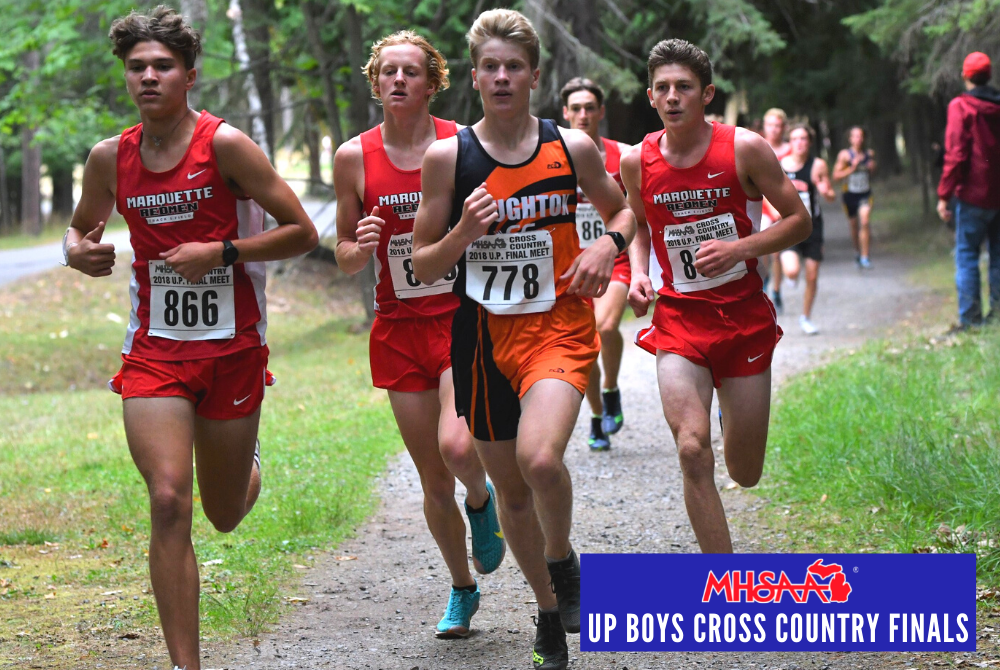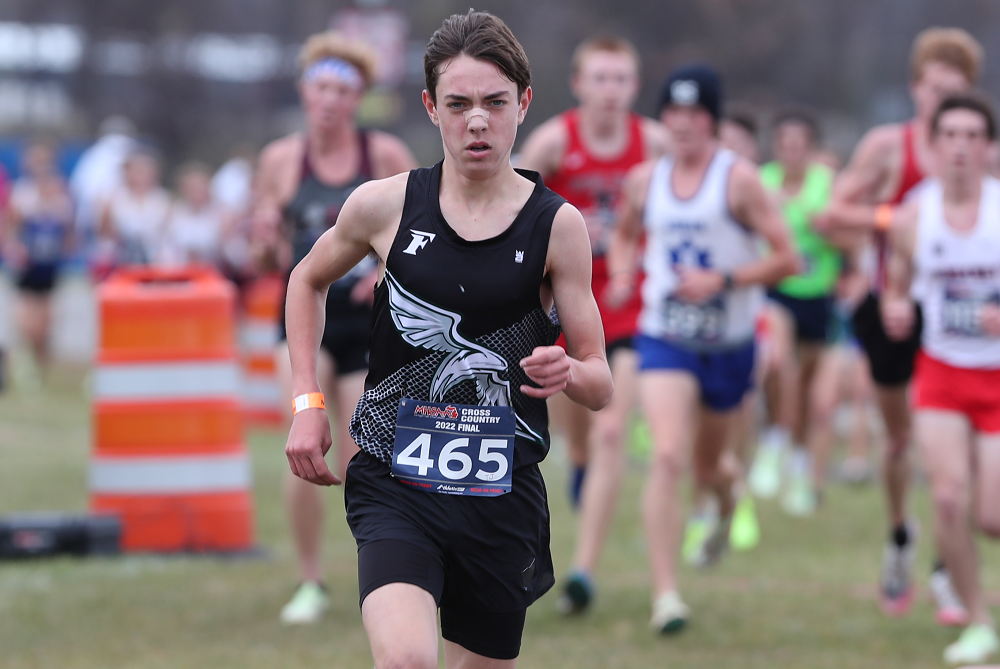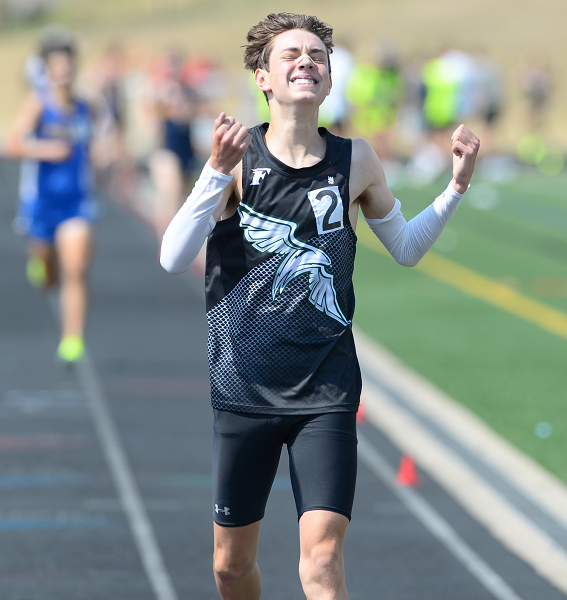
Preview: Next Challengers Set to Take Championship Strides
By
Geoff Kimmerly
MHSAA.com senior editor
October 22, 2021
A total of 17 top-10 individual finishers from last season’s Upper Peninsula Boys Cross Country Finals graduated this spring – resulting in a possible new look to at least one championship race Saturday at Gentz’s Homestead Golf Course in Marquette.
While Marquette remains an annual favorite in Division 1 and Dollar Bay looks like the team to chase again in Division 3, Division 2 might be a little less predictable for the first time in a while as always-speedy Ishpeming is among those bringing a mostly-new crew. Similarly, only one 2020 individual champion will return this weekend, and from a Division 3 also welcoming a number of new contenders.
Saturday’s races begin with the Division 1 girls at 11 a.m. and conclude with the Division 3 boys at 1:30 p.m. Check back Saturday evening for coverage, and see below for more teams and individuals to watch. (Click for race information and competitors.)
Division 1
Reigning champion: Marquette
2020 runner-up: Sault Ste. Marie
Top-ranked: 1. Marquette, 2. Houghton, 3. Calumet.
Marquette is seeking its third-straight Division 1 title after edging Sault Ste. Marie by nine points last season and six in 2019. Five of last season’s top seven runners will race again this weekend, including juniors Carson and Colin Vanderschaaf (who placed third and fifth, respectively, in 2020) and senior Luke Janofski (sixth) as all five Marquette returnees finished among the top 19 individuals overall. Senior Eric Weiss was the individual runner-up last season to lead Houghton’s third-place team finish, and he’s one of three back from that lineup. Sault Ste. Marie should figure in significantly again with four runners back from last season’s lineup (including three who placed among the top 19 overall), led by junior Cody Aldridge (eighth) and senior Riley Eavou (ninth).
Individuals: Total, 10 from last season’s top 20 will be back this weekend. Gladstone junior Drew Hughes is another to watch after finishing 12th a year ago and fifth as a freshman.
Division 2
Reigning champion: Ishpeming
2020 runner-up: Painesdale Jeffers
Top ranked: 1. Painesdale Jeffers, 2. Ironwood, 3. St. Ignace.
Ishpeming has won the last three Division 2 titles and six of the last seven, but graduated its top five runners from last season’s team and returns this weekend with five sophomores and a freshman. Painesdale Jeffers graduated four of its five runners from last season’s runner-up team, with junior Tavin Larson hoping to lead the next five to the front after taking fourth individually in 2020. Ironwood returns four runners from its fourth-place team finish, led by junior Tyler Smith (14th).
Individuals: Half of last season’s top 20 individual finishers graduated, and total seven runners will return this weekend from that remaining group. Larson is the highest-returning placer, followed by West Iron County sophomore John Swenski (eighth) and Ishpeming sophomore Parker Gauthier (10th).
Division 3
Reigning champion: Dollar Bay
2020 runner-up: Rudyard
Top ranked: 1. Dollar Bay, 2. Brimley, 3. Brimley Ojibwe Charter.
Dollar Bay went from runner-up in 2019 to winning its first championship in 2020, and four of its top six from last year will run this weekend with junior Cooper Stout returning after finishing sixth individually. Big things are expected from Brimley with four of its top five back after finishing fifth last season, and Ojibwe Charter brings back two of three individual qualifiers from a year ago as it seeks a high team finish. Stephenson is an interesting possibility with its top six runners back from last year’s team that finished fourth, including junior Griffin Brown (ninth individually) and senior Corey Buckley (11th).
Individuals: Half of the Division 3 top 20 from last season also graduated, but nine of the remaining 10 will be back Saturday. Ewen-Trout Creek senior Jonah Nordine is the reigning champ after clearing the field last season by nearly 25 seconds. Engadine junior Conrad Spieles also returns from the top 10 after placing ninth last fall.
PHOTO Marquette's Luke Janofski (866) and Colin Vanderschaaf (870), Houghton's Eric Weiss (778), and Marquette's Brady Ketzenberger (867) run at the Queen City Invitational this season. (Photo by Cara Kamps.)

Freeland's Hansen Not Focused on Joining All-Time Greats - But On His Way
By
Paul Costanzo
Special for MHSAA.com
September 29, 2023
The goal written on Matt Kaczor’s Post-It Note was sub-15 minutes, 15 seconds. That’s what the Freeland cross country coach was hoping for from star runner TJ Hansen during his junior season.
 Kaczor tore it up after seeing Hansen run a single race this fall.
Kaczor tore it up after seeing Hansen run a single race this fall.
“Knowing what he did over the summer and where he was at, seeing what his 1,600 (meter) and his mile got down to, I had a feeling he could get under 15:30 quickly,” Kaczor said. “After the first race, I looked at my assistant and was like, ‘I’ve gotta rip up that Post-It Note. I don’t think our goal is on the level of where he’s at right now.’ At first, it was break 15:15. Once I saw him race at the Under the Lights (on Aug. 18 at St. Johns), I was like, ‘Yeah, he’s going sub 15.’”
Hansen ran 15:39.6 in that first race, and on Sept. 7, in Shepherd, he ran 15:13.9 to meet the goal written on the now-shredded Post-It Note.
This past Saturday, he ran 15:03.7 at the Cadillac Veterans Serving Veterans Invitational. It’s the fastest time recorded in Michigan this year, and a signal that Kaczor might be filling out a new Post-It Note before the season is out.
“The sub-15 barrier, that’s been something on my mind for a while,” Hansen said. “Now that I’m edging closer and closer to that, it’s been exciting. With how heavy my training has been, I wouldn’t expect (to have run this fast this early). Being able to run the times I am really paints the picture for what’s ahead.”
Hansen came into the season already regarded as one of the elite distance runners in the state. He won the 3,200 meters at the MHSAA Lower Peninsula Division 2 Track & Field Finals this past spring. He’s also finished all-state (12th and fifth, respectively) the past two seasons at the LPD2 Cross Country Finals.
His current trajectory, however, would put his name near some of the state’s all-time greats. But that’s not something Hansen is focusing on.
“I really don’t like to compare myself to others,” he said. “I don’t focus on that. I try to be the best TJ Hansen that I can be. The best version of myself.”
Focusing on himself is almost necessary for Hansen, as he’s spending a lot of time during his races running by himself.
At each of the big events Freeland has run in this season, Hansen has finished at least 20 seconds ahead of his nearest competitor. That includes all divisions of the Duane Raffin Festival of Races in Holly.
In Cadillac, where Hansen ran his current best time, he was a full minute ahead of the rest of the field.
 “He’s just a special athlete,” Kaczor said. “I can’t see Freeland having someone like this in a while. He’s a generational talent. What’s crazy is, I had the school record when he was a freshman. He and Braden (Honsinger) broke it last year. But TJ has now dropped that school record (set in 1998) by almost a minute.”
“He’s just a special athlete,” Kaczor said. “I can’t see Freeland having someone like this in a while. He’s a generational talent. What’s crazy is, I had the school record when he was a freshman. He and Braden (Honsinger) broke it last year. But TJ has now dropped that school record (set in 1998) by almost a minute.”
Hansen’s achievements have already put him on a path to run at the next level, which is something of a family tradition.
His older sisters Peyton and Kiera are track & field athletes at Wayne State and Eastern Michigan, respectively. Their parents, Tim and Pam, were track & field stars at Central Michigan.
TJ has drawn the attention of coaches around the country, including from Michigan, Michigan State, Wisconsin, Tennessee and Colorado.
Having family members who know the process is a help for Hansen, and he said they’ve all been good about allowing him to choose his own path, whatever that may be.
“He’s from a good family that knows how to work and knows how to get things done,” Kaczor said. “He knows that if he puts in the work, he’s going to be at a good spot.”
While Hansen admits it can be a bit overwhelming, he’s using it as motivation to run faster and continue to put his name out there.
Also serving as motivation is 2022 Division 2 champion Connell Alford of Chelsea. Alford is among the elite group of runners in Michigan who have broken the 15-minute mark, doing it twice a year ago.
He currently has the state’s second-best time behind Hansen’s this year, running 15:09.1 at the MSU Invitational on Sept. 15.
“Whenever I see him drop a time, my main goal is to run faster,” Hansen said. “Whenever I see him run a good time, that motivates me to work hard.”
The two won’t see each other until the MHSAA Finals on Nov. 4 at Michigan International Speedway. It’s an opportunity Hansen is excited for, as it’s a chance to race and be pushed toward the lofty goals he’s set for himself. Kaczor is excited about it, too, even if it might mean having to replenish his supply of Post-Its.
“We don’t talk about winning the state title; we talk about making sure that we have great races on those days,” Kaczor said. “We can’t control how somebody else runs. It’s a matter of can we, if the weather is right and the course is in good condition, can we be one of the few guys that has run in the 14s on that course? That’s the goal. Put yourself in some great categories with those upper echelons and the greats of all-time.”
 Paul Costanzo served as a sportswriter at The Port Huron Times Herald from 2006-15, including three years as lead sportswriter, and prior to that as sports editor at the Hillsdale Daily News from 2005-06. He can be reached at [email protected] with story ideas for Genesee, Lapeer, St. Clair, Sanilac, Huron, Tuscola, Saginaw, Bay, Arenac, Midland and Gladwin counties.
Paul Costanzo served as a sportswriter at The Port Huron Times Herald from 2006-15, including three years as lead sportswriter, and prior to that as sports editor at the Hillsdale Daily News from 2005-06. He can be reached at [email protected] with story ideas for Genesee, Lapeer, St. Clair, Sanilac, Huron, Tuscola, Saginaw, Bay, Arenac, Midland and Gladwin counties.
PHOTOS (Top) Freeland's TJ Hansen leads a pack during last season's LPD2 Final at Michigan International Speedway. (Middle) Hansen enjoys a moment of exhilaration after winning the 3,200 this spring at the LPD2 Finals at Ada Forest Hills Eastern. (Top photo by Carter Sherline/Run Michigan; middle photo by Dave McCauley/Run Michigan.)

